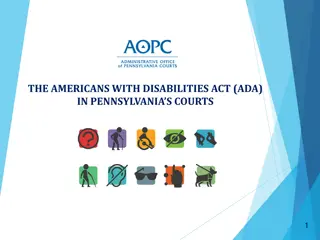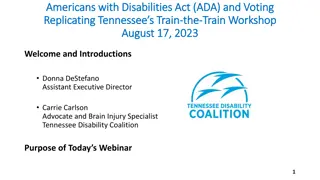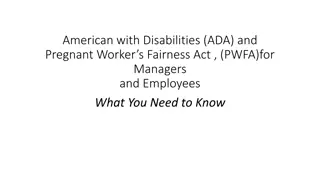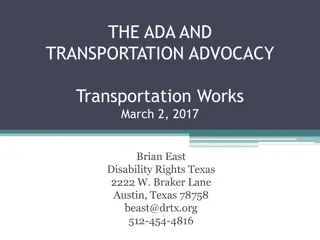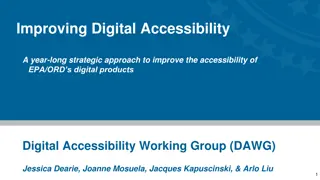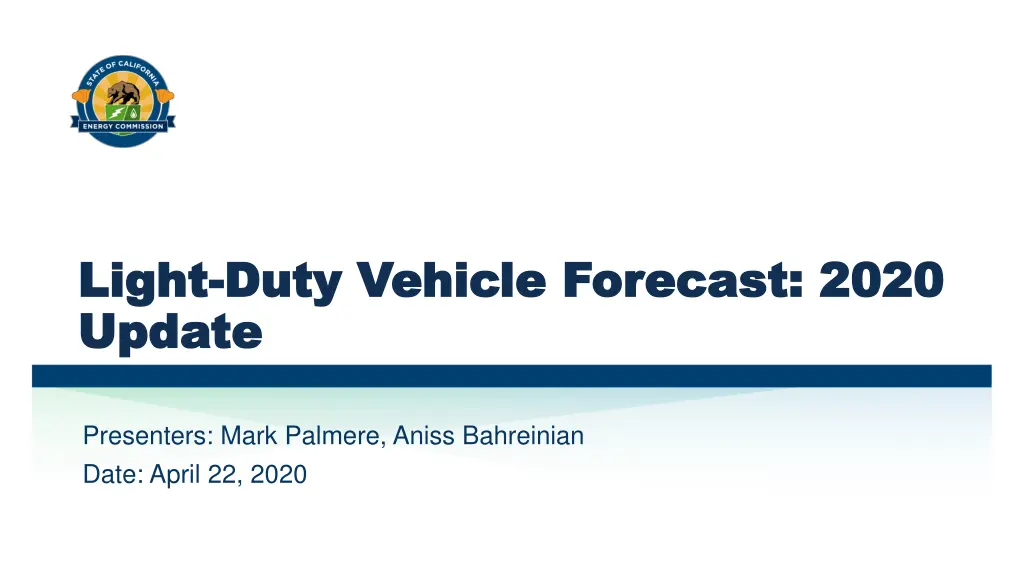
Light-Duty Vehicle Forecast 2020 Update Insights
Explore the latest updates in the light-duty vehicle forecast for 2020, including adjustments due to COVID-19 disruptions, ZEV scenarios, incentives, and more. Stay informed about changes in economic and demographic forecasts impacting the vehicle industry.
Download Presentation

Please find below an Image/Link to download the presentation.
The content on the website is provided AS IS for your information and personal use only. It may not be sold, licensed, or shared on other websites without obtaining consent from the author. If you encounter any issues during the download, it is possible that the publisher has removed the file from their server.
You are allowed to download the files provided on this website for personal or commercial use, subject to the condition that they are used lawfully. All files are the property of their respective owners.
The content on the website is provided AS IS for your information and personal use only. It may not be sold, licensed, or shared on other websites without obtaining consent from the author.
E N D
Presentation Transcript
Light Light- -Duty Vehicle Forecast: 2020 Duty Vehicle Forecast: 2020 Update Update Presenters: Mark Palmere, Aniss Bahreinian Date: April 22, 2020
Several Several Inputs Inputs Will Be Updated Will Be Updated Base year vehicle stock. The LDV forecast will use DMV s 2019 vehicle population. Economic and Demographic forecasts. These consist of population (number of households), income (real earnings per household), and Gross State Product. Incentives. CARB recently reduced the state rebate (CVRP) from $2,500 to $2,000 for BEVs, and from $1,500 to $1,000 for PHEVs. This announcement came too late to be accounted for in the 2019 forecast but will be reflected in 2020 forecast. 2018 American Community Survey data. Base year inputs from ACS, such as household makeup distribution and vehicles per household, will be updated. Fuel prices will also be updated. 2
COVID COVID- -19 Disruptions Will Be Considered 19 Disruptions Will Be Considered For the LDV forecast this will be reflected in the following ways: Updated Economic and Demographic forecasts, specifically Households, Income, and Gross State Product. This affects total vehicle population. DMV registration data through June 2020 will be used to adjust forecast based on the actual 2020 sales, given the possibility of disruption to the market. This will show us potential changes in vehicle population makeup. We will also be tracking any long-term effect on Vehicle Miles Traveled. 3
ZEV Scenarios See Limited Change ZEV Scenarios See Limited Change Demand Case Low Mid High Aggressive Bookend Preferences Increase With ZEV Market Growth Increase With ZEV Market Growth Increase With ZEV Market Growth Increase With ZEV Market Growth Consumers' ZEV Preference Constant at 2017 Level Incentives Decreasing, eliminated after 2022 Federal Tax Credit Decreasing Decreasing Decreasing Decreasing BEV: $2,000 FCEV: $4,500 To 2030 PHEV: $1,000 To 2025 To 2025 BEV: $2,000 PHEV: $1,000 FCEV: $4,500 To 2025 BEV: $2,000 PHEV: $1,000 FCEV: $4,500 To 2025 BEV: $2,000 PHEV: $1,000 FCEV: $4,500 To 2030 BEV: $2,000 PHEV: $1,000 FCEV: $4,500 To 2030 State Rebate To 2025 To 2025 To 2030 To 2030 HOV Lane Access Attributes in 2030 BEV: 11 PHEV: 14 FCEV: 5 BEV: 12 PHEV: 14 FCEV: 5 BEV: 13 PHEV: 14 FCEV: 6 BEV: 13 PHEV: 14 FCEV: 6 BEV: 15 PHEV: 14 FCEV: 6 Classes Available (out of 15 total classes) PEVs: Prices based on battery price declining to ~$120/kWh FCEVs: $38,000 PEVs: ~333 FCEVs: ~365 PEVs: 15-21 PEVs: same as gasoline PEVs: Prices based on battery price declining to ~$100/kWh FCEVs: $25,000 PEVs: ~341 FCEVs: ~365 PEVs: 15-21 PEVs: same as gasoline PEVs: Prices based on battery price declining to ~$80/kWh FCEVs: $25,000 PEVs: ~341 FCEVs: ~461 PEVs: 10-16 PEVs: same as gasoline PEVs: Prices based on battery price declining to ~$70/kWh FCEVs: $25,000 PEVs: ~341 FCEVs: ~461 PEVs: 10-16 PEVs: same as gasoline by 2025 PEVs: Prices based on battery price declining to ~$70/kWh FCEVs: $25,000 PEVs: ~341 FCEVs: ~461 PEVs: 10-16 PEVs: same as gasoline by 2025 Vehicle/Battery Price Max Range for a Midsize Vehicle (Mi) Refuel Time (minutes) Time to Station 4
Update Scheduled to be Update Scheduled to be Completed by Fourth Quarter Completed by Fourth Quarter Staff has already begun updating these LDV inputs. Here is an estimated timeline (all dates subject to change): 2nd Quarter 2020 Modify Incentives input Receive 2019 DMV Population Receive Updated Economic and Demographic forecasts 3rd Quarter 2020 Receive Q1+2 2020 DMV sales estimates Update fuel prices 4th Quarter 2020 Deliver Forecast Update 5
ANTICIPATED UPDATES FOR ANTICIPATED UPDATES FOR 2021 2021 LIGHT LIGHT DUTY VEHICLE CHOICE DUTY VEHICLE CHOICE MODEL MODEL AND AND FORECAST FORECAST
2019 Survey Update 2019 Survey Update The 2019 California Vehicle Survey (CVS) data collection phase has been completed. 2019 survey has made changes to survey data that create more potential for model changes. Data changes include: Augmented ZEV owner sample Contains more data on charging infrastructure Differentiates between luxury and standard vehicles Reduced number of LDV classes from 15 to 13 More data on ride sharing 7
2021 Model and Forecast Update 2021 Model and Forecast Update The model structure will remain the same, for the 2021 IEPR. The model parameters will change based on the 2019 CVS data. The number of LDV classes will change and we anticipate differentiating between luxury and standard vehicles. This will almost double our vehicle attribute forecast data. Staff are working on the corresponding changes to DMV data, to be used in base year. We are exploring addition of an income dimension, and perhaps a luxury dimension, to the state rebate incentives in our model & software, to align them with the actual state rebate policies. 8



